Unsure about your French table manners? Click Here to download > > How to avoid these 10 food etiquette mistakes !
- Home ›
- Destinations ›
- Normandy ›
- Things to Do in Bayeux, France
Bayeux, France: Vikings, Conquerors And The Roar Of Tanks
Published 25 February 2025 by Leyla Alyanak — Parisian by birth, Lyonnaise by adoption, historian by passion
NOTE: THE BAYEUX TAPESTRY IS CLOSED FOR RENOVATIONS UNTIL THE FALL OF 2027
Bayeux has seen it all − Viking raids, Norman conquests, and the clatter of Allied tanks. Somehow, it emerged unscathed and is one of Normandy’s best-preserved historic towns. There are plenty of things to do in Bayeux, from visiting the 11th-century Bayeux Tapestry to wandering the medieval streets of this charming town.
Bayeux doesn't have one history: it has several.
First the Romans came, then the Vikings, then William the Conqueror sped by and, more recently, a major part of World War II took place minutes away.
Yet somehow, despite these comings and goings, Bayeux seems to have escaped relatively unscathed.
The few times the city was sacked or destroyed, it revived.
What made Bayeux so resilient? That in itself was a good reason to visit, but there are many others.
Let me introduce you to the lovely Norman city that captured my heart and show you some of the unforgettable things to do in Bayeux.
Things to see and do in Bayeux
- 1. Explore the Bayeux Tapestry in detail
- 2. Witness the changing face of Notre-Dame Cathedral
- 3. Stroll through Bayeux’s Old Town
- 4. Relive the past at the Battle of Normandy Memorial Museum
- 5. Pay your respects at the Bayeux War Cemetery and Memorial
- 6. Pay homage to reporters who died at war
NOTE: Pages on this site may contain affiliate links, which support this site. See full Privacy Policy here.
Things to see and do in Bayeux
The first time I visited Bayeux, I used it as the perfect base for the D-Day beaches. The second time, I went for the Bayeux tapestry. By the third visit, I was truly in love with Bayeux's history, never mind its cobblestone streets or old stone houses or medieval cathedral.
Bayeux’s luck and strategic value have made it one of Normandy’s best-preserved historic towns, and I wanted to spend a bit of time to discover all of the fun things to do in Bayeux.
1. Explore the Bayeux Tapestry in detail
It's hard to explain the immensity and depth of this 70-meter long masterpiece, an 11th century storyboard (or comic book!) that sets out the story of the Norman conquest of England and the Battle of Hastings.
From the moment you enter until you leave, you'll be mesmerized by the hand-sewn panels that describe everything from the loading of horses onto the boats of the invasion fleet to the death of King Harold and the passing of Halley’s Comet − and all of it took place in 1066, right in the Middle Ages.
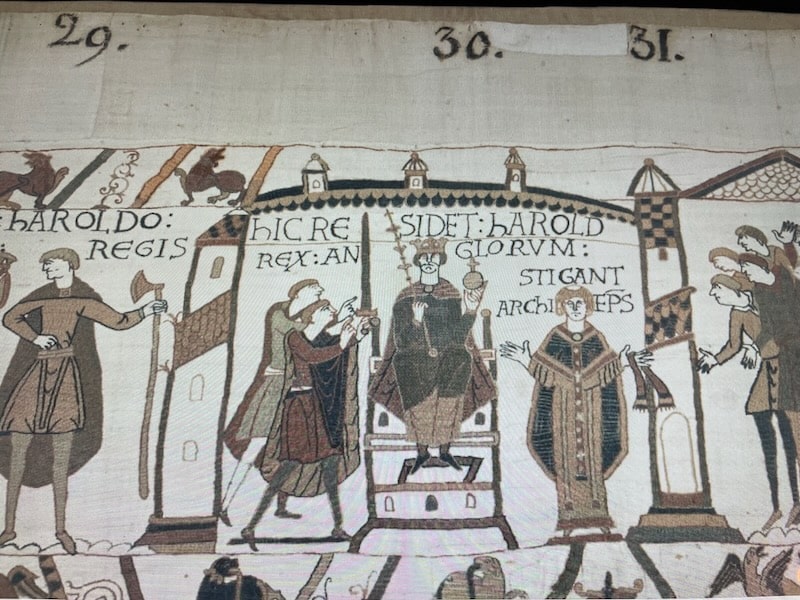
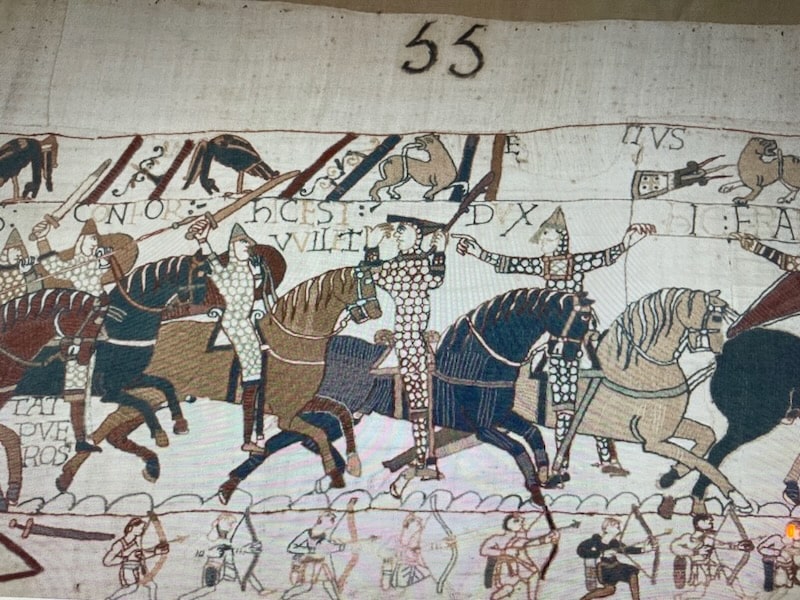 The famous Bayeux Tapestry is listed in UNESCO’s Memory of the World Register, which protects significant documentary heritage @OffbeatFrance
The famous Bayeux Tapestry is listed in UNESCO’s Memory of the World Register, which protects significant documentary heritage @OffbeatFranceFor all its fame, the legendary tapestry is actually incomplete: the end is missing, as are a few other segments. Some believe the final scenes were deliberately removed and may have illustrated William the Conqueror’s later years or Odo’s rebellion (he was William’s half brother).
Could there be another lost part of the tapestry hidden somewhere?
2. Witness the changing face of Notre-Dame Cathedral
Notre Dame Cathedral, a historic monument, is a marvel of Gothic architecture, and you’ll be passing it often during your stay.
Here we can see Norman architecture at its finest: the Bayeux Cathedral was consecrated in 1077, in the presence of William the Conqueror.
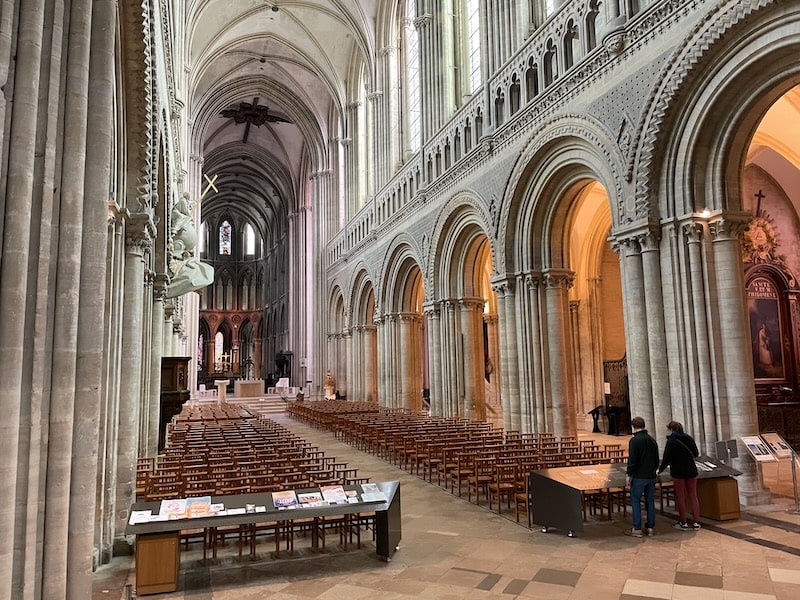
Over time, Gothic elements were added, giving us the pointed arches, ribbed vaults and slender columns that now dominate the interior. Flying buttresses outside keep it standing tall.
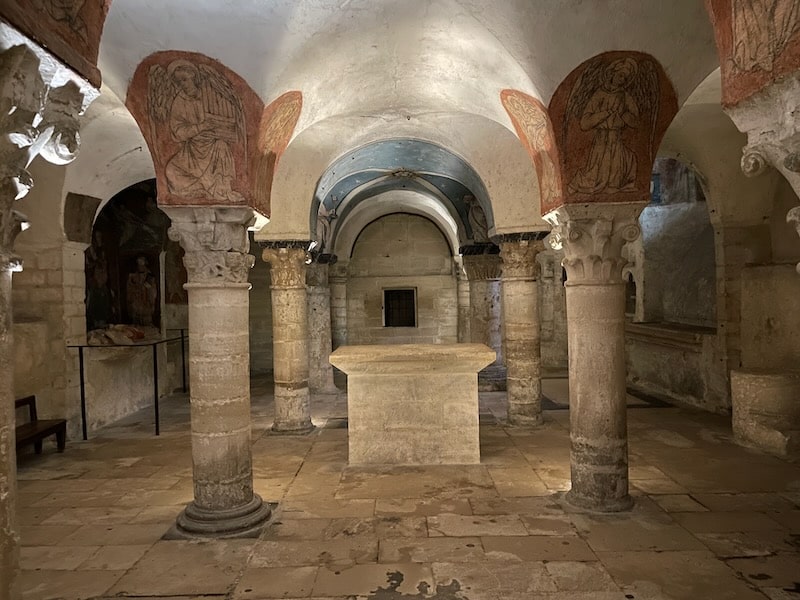
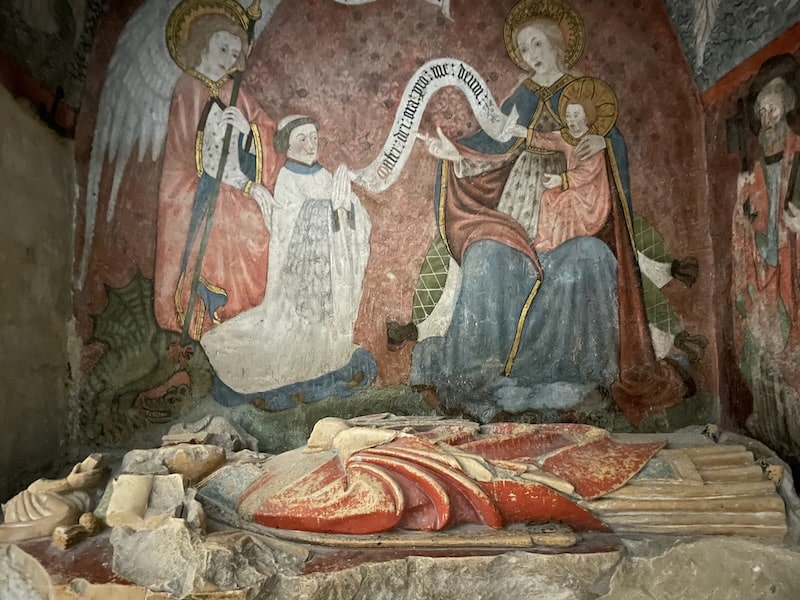 Step inside, and the Romanesque crypt pulls you underground, with its stone columns and faded frescoes that are remnants of the 12th century ©OffbeatFrance
Step inside, and the Romanesque crypt pulls you underground, with its stone columns and faded frescoes that are remnants of the 12th century ©OffbeatFranceWhile some medieval fragments survive, many original windows were shattered during World War II.
In their place, post-war artisans crafted new glass, a fusion of traditional themes and contemporary designs. From the back of the cathedral, look up and to your left. you'll see the modern additions.
 Some windows depict the Virgin Mary, other more modern ones (see upper left windows) honor the liberation of Bayeux in 1944 @OffbeatFrance
Some windows depict the Virgin Mary, other more modern ones (see upper left windows) honor the liberation of Bayeux in 1944 @OffbeatFranceIt’s that contrast − the medieval stonework, Norman history, and the 20th-century glass reflecting a town that survived yet again − that makes this cathedral more than just a relic.
3. Stroll through Bayeux’s Old Town
The Old Town isn't very big, but it's a delight with its working water wheels, half-timbered houses and stone bridges which have remained the same for centuries, barring an extra shop or two.
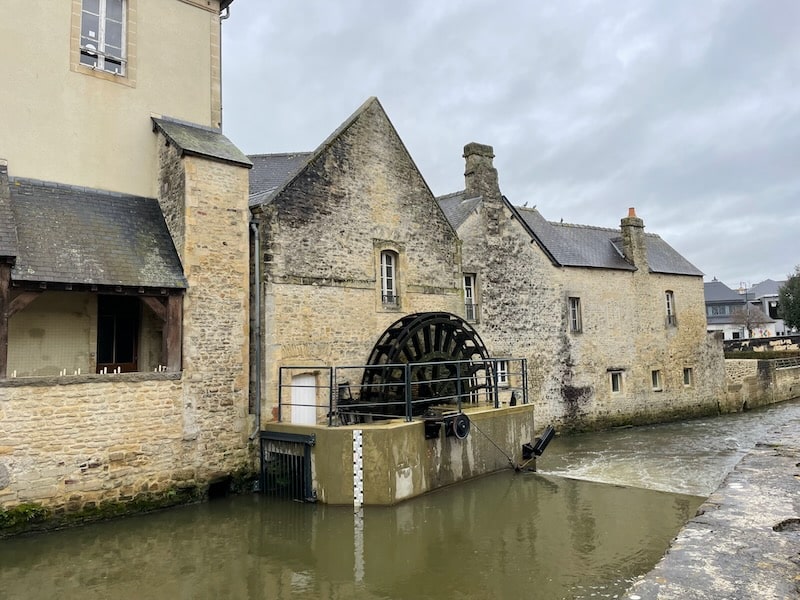 The River Aure is where you'll find the working water wheels, which once powered mills during Bayeux’s textile heyday. The best-preserved example stands near the Place Charles de Gaulle, but frankly, the waterways are all lovely ©OffbeatFrance
The River Aure is where you'll find the working water wheels, which once powered mills during Bayeux’s textile heyday. The best-preserved example stands near the Place Charles de Gaulle, but frankly, the waterways are all lovely ©OffbeatFranceThe Rue des Cuisiniers (Street of the Cooks) is a narrow medieval street filled with restaurants. Once home to guilds of cooks serving pilgrims and merchants, it still has an inviting and convivial aura, with some façades dating back to the 14th century. Midway down the street is a little crêperie which, unusually for France, is open all day.
The street extends into the Rue du Bienvenu, which is where the cathedral is located. Across the street from the cathedral is an unusual establishment called the Conservatoire de la Dentelle, or Conservatory of Lace. The city has been known for its lace since the early 17th century, and there is even a Lace Route (blog in French) that goes through this particular part of Normandy.
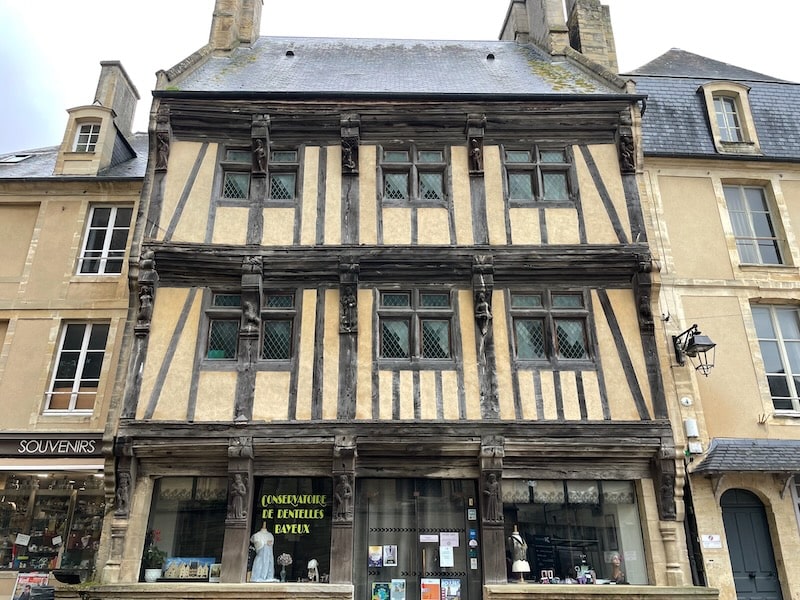 Adam and Eve's house in Bayeux ©OffbeatFrance
Adam and Eve's house in Bayeux ©OffbeatFranceThe conservatory, by the way, is located in what is known as Adam and Eve's house (Maison d’Adam et Eve), one of Bayeux’s oldest timber-framed houses. If you look closely, one sculpture apparently shows Adam and Eve, although I never saw this because I only read about it after leaving town. I guess I'll have to return to Bayeux yet again!
If all this sightseeing makes you hungry, I've got the perfect place for you: the Patisserie Reine-Mathilde (Queen Mathilde was William the Conqueror’s wife) on the main street, Rue Saint-Martin.
It dates back to 1898 and has somehow managed to hold on to its Old World charm and recipes without sacrificing modern culinary techniques and lightness. Have a look!

You can also drop by the tourist office to book a tour with a travel guide knowledgeable in local history.
4. Relive the past at the Memorial Museum of the Battle of Normandy
The Battle of Normandy Museum is located in Bayeux because it was the first city to be liberated by Allied forces after the D-Day landings on 6 June 1944.
The museum was built to preserve that memory and document the 77-day battle that followed, which led to the liberation of Normandy and ultimately of Western Europe.
Most of what you’ll see centers on the military campaign, from Operation Overlord through the difficult advance across the marshy bocage countryside.
Detailed maps show troop movements, and photographs and film reels capture the devastation of war, along with uniforms, weapons and personal items from soldiers like letters, helmets or field gear which were left behind.
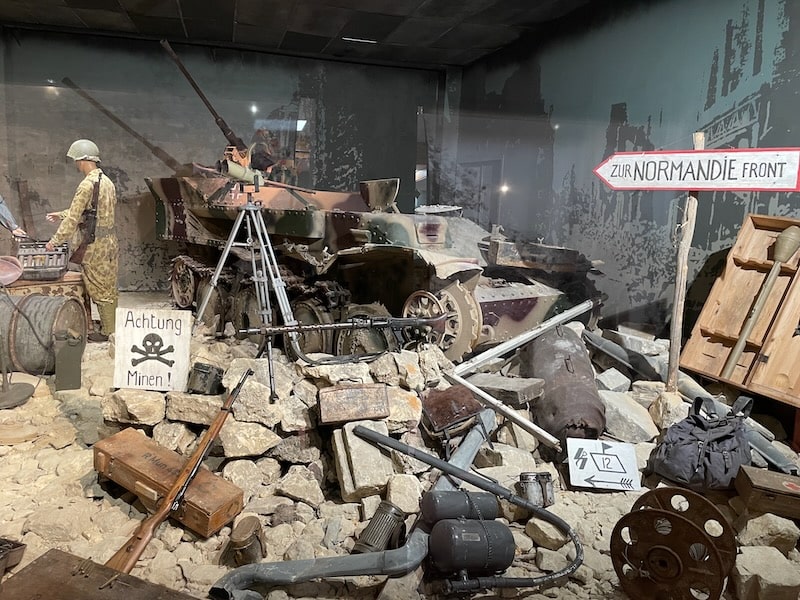 Personal items and scenes of war at the Bayeux Museum @OffbeatFrance
Personal items and scenes of war at the Bayeux Museum @OffbeatFrance One notable exhibit features a Sherman tank, sitting almost defiantly outside, a reminder of the machinery that drove the liberation forward @OffbeatFrance
One notable exhibit features a Sherman tank, sitting almost defiantly outside, a reminder of the machinery that drove the liberation forward @OffbeatFranceIf you're interested in this period of history, you should definitely go because the D-Day landing beaches tell only part of the story. Here, at the museum, you'll understand what happened after the landings, as men fought their way through hedgerows and paid such a high price for every mile of freedom.
RECOMMENDED TOURS FROM BAYEUX TO THE D-DAY BEACHES
One of my challenges in Bayeux was getting to the several D-Day beaches, since I was traveling without a car. There are limited public transportation options, and getting from one beach to the next wastes quite a bit of time. If you don't have a car, I strongly recommend you take a tour; you'll see and learn a lot more.
➽ Full-day tour retracing American soldiers' footsteps
➽ Half-day tour if time is tight
➽ Full-day D-Day visit to Juno Beach for a Canadian perspective
➽ Full-day PRIVATE tour, if you're with your family or a small group of friends
➽ Exciting half-day tour by sidecar
PS. If you need to rent a car, you'll probably have to do it in nearby Caen – availability in Bayeux is very limited. You can use this search engine to find the best prices.
5. Pay your respects at the Bayeux War Cemetery and Memorial
Just a few meters from the busy ring road, you can step in to the Bayeux War Cemetery and suddenly the noise seems to fade.
This is the largest Commonwealth cemetery in France from World War II, with 4144 graves, most from the Battle of Normandy after D-Day. Among them, 3935 are Commonwealth soldiers, while 209 graves belong to other nationalities, mostly German.
Some names are known, with regiments and dates carefully inscribed in stone. Others are not. Their headstones read only: “A Soldier of the Second World War Known Unto God.”
Across from the graves is the Bayeux Memorial with the names of 1808 men with no known resting place. “We, once conquered by William, have now set free the Conqueror’s native land.”
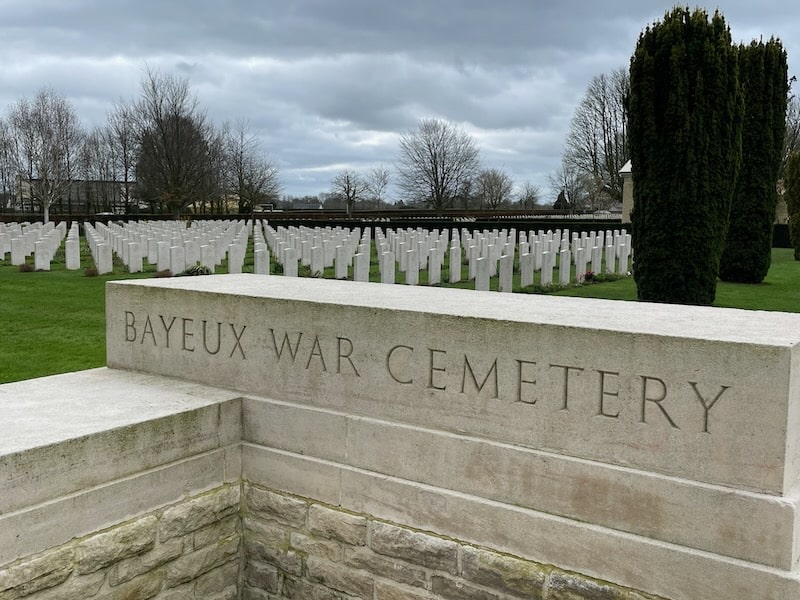
The cemetery is quiet, impeccably kept by the Commonwealth War Graves Commission, and open year-round, free to all.
Visitors often leave poppies or crosses, or stand in silence, using their fingers to trace the names of those who never went home.
Having walked the D-Day beaches, this is where the story ends for many who landed there.
6. Pay homage to reporters who died at war
A short walk in a quiet park behind the Bayeux Memorial is a memorial of a different kind, unique in Europe: this is a memorial to the more than 2000 reporters who died since 1944 while trying to bring us the truth of world affairs.
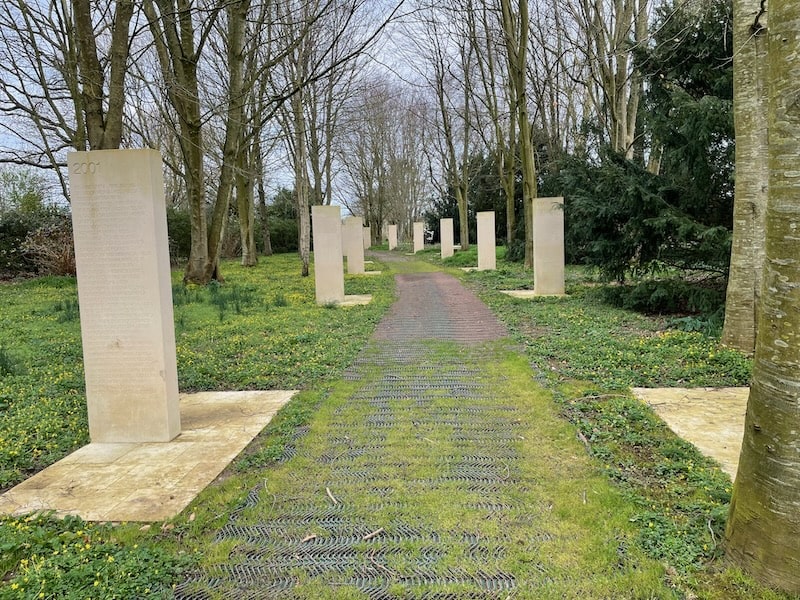 New names are added every year, a reminder that the risks have not faded ©OffbeatFrance
New names are added every year, a reminder that the risks have not faded ©OffbeatFranceThere are names from every continent, some famous, others known only in their home countries. They are listed by year, and covered wars you watched on TV or read about in the paper.
It's a thoughtful walk, and one of the top things I did in Bayeux, especially if you've ever read a reporter's work to better understand a conflict far from home.
Bayeux, the city that refused to be destroyed
Most visitors associate Bayeux with William the Conqueror, but its roots go back much further. Before the Normans, the Celts and Romans controlled Bayeux. The town was known as Augustodurum in Roman times and was an important strategic hub.
Little is left from that time, although should excavations take place, there's little doubt that remnants of that era would miraculously appear…
Meantime, if you’re looking for physical evidence of that past, the Musée d’Art et d’Histoire Baron Gérard has a small collection of Roman-era artifacts, including pottery, coins and remnants of daily life in Bayeux during the 1st-3rd centuries CE.
It may lack ramparts and Roman ruins, but what Bayeux did have plenty of was the will to survive.
It survived the Viking raids
Sometime around 890 CE, Bayeux was attacked and sacked by Vikings, part of the wider Norse invasions across Normandy.
Bayeux’s ruling count was killed, but the town itself recovered and became part of the emerging Duchy of Normandy under Viking leader Rollo. While plenty of other towns were destroyed, Bayeux was rebuilt and thrived.
Two centuries later, it escaped the wrath of William the Conqueror
After William consolidated his power over Normandy, towns that resisted him were often pillaged and burned.
Not Bayeux, though, which was protected by Odo, his half-brother (who by the way probably commissioned the Bayeux Tapestry). Thanks to Odo, Bayeux would flourish. He palyed a key role in securing Norman rule and in supplying men and resources for the conquest.
The Bayeux Tapestry may tell the story of William the Conqueror’s invasion of England, but it doesn’t detail Bayeux’s role as a key power center before and after 1066, so we don't know much about this period.
It was spared destruction during Hundred Years’ War
The English captured Bayeux in 1417, during Henry V’s campaign in Normandy.
Unlike Caen, which was sacked, Bayeux was occupied relatively peacefully, and its cathedral and core buildings left standing.
The town remained under English control until 1450, when it was reconquered by the French, again without major devastation.
Bayeux was caught between English and French forces during the Hundred Years’ War. It changed hands multiple times, suffered destruction, and was heavily fortified, surviving the maelstrom.
It escaped bombing and destruction during World War II
Bayeux was the first major town liberated by the Allies (7 June 1944), the day after D-Day.
Unlike Caen, Bayeux was taken almost without a fight, since the Germans had already withdrawn.
The center of the medieval city, cathedral and historic buildings were spared, making it one of the few towns in Normandy to emerge from the war virtually intact.
It also briefly served as the capital of Free France and would be a key base for the Allies during the Battle of Normandy.
Why was it so resilient?
Despite a series of successive close calls throughout history, Bayeux somehow survived and thrived. How could that be?
- Bayeux sits slightly inland from the Norman coast and away from major political or economic hubs like Rouen or Paris, making it less attractive for strategic attacks. This relative isolation protected it from more destructive battles.
- The town had a varied economy, with agriculture and a thriving textile industry, including lace-making and wool production. This economic diversity gave it resilience, unlike single-industry towns that struggled during crises.
- As an episcopal seat since the 4th century, Bayeux was wealthy and stable, enjoying the Church’s protection. Whenever it suffered damage, the Church and local rulers had a vested interest in rapid reconstruction.
- Bayeux’s status as a regional seat with a strong economic base ensured it was always rebuilt after conflicts, such as the Viking raids. Unlike towns that fell into ruin after wars or plagues, it was never abandoned.
- At various times, powerful figures like Odo of Bayeux provided additional protection.
- While many Norman towns were devastated in the Hundred Years’ War and the Wars of Religion, Bayeux was often spared the worst fighting because it was neither a fortress nor a capital.
- Unlike cities that industrialized heavily in the 19th century and became military or factory hubs, Bayeux remained more traditional, avoiding the large-scale destruction seen in industrialized regions during modern wars.
- Since it wasn't a key World War II German stronghold, the Allies avoided bombing it. They moved quickly through, building a ring road because the medieval streets were too narrow. And so, it was spared.
Getting to Bayeux
Bayeux is easy to reach:
- By direct train from Paris or Caen. The Paris to Bayeux train leaves from Paris St Lazare station − the trip takes about 2hrs 20. You can buy your tickets from Trainline.
- By car via the A13 in about 3 hours. If you don’t have a car, you can compare rental prices here.
Hotels in Bayeux, France
Bayeux is popular and there are plenty of places to stay. Here are a few I’ve picked out for you:
- For a historic hotel in the heart of Bayeux, choose either the Hotel D’Argouges or Le Castel Guesthouse
- Ready to splurge? Then you’ll head for the Villa Lara
- If you’d rather have your own apartment, this one has a little garden and is right in the heart of town
- And if you’d rather not spend your money on accommodations, there’s always the rock-bottom, very basic Premiere Classe
Before you go...
Part of what enchants visitors about France is its impossibly rich history, which spans millennia. I’ve been bitten by the history bug so if you want to take a peek, here is a selection of stories that in one way or another involve French history:
- A Day In The Life Of Louis XIV, Sun King
- Napoleon Bonaparte: The Man The French Love To Hate
- 10 Startling Facts You Need To Know About The French Revolution
- Belle Epoque in France: Golden Age Or Gilded Illusion?
And if you want to take an even deeper dive into French history, you'll find me on Substack as Gallia Incognita.
Did you enjoy this article? I'd love if you shared it!

